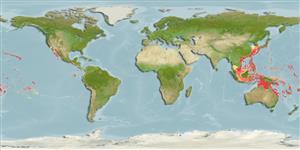Common names from other countries
Environment: milieu / climate zone / depth range / distribution range
Ecologia
marinhas associadas(os) a recifes; intervalo de profundidade 6 - 130 m (Ref. 89972). Subtropical; 35°N - 31°S
Pacific Ocean: antitropical, from southern Japan, Hawaiian Islands, Clipperton Island, Revillagigedo Islands, southern California, Easter Island, and Pitcairn Islands.
Tamanho / Peso / Idade
Maturity: Lm ? range ? - ? cm
Max length : 30.0 cm NG macho/indeterminado; (Ref. 89467)
Espinhos dorsais (total) : 3; Raios dorsais (total) : 29 - 32; Espinhos anais: 0; Raios anais : 26 - 29. Males are straw-yellow with each scale outlined in black creating a crosshatched appearance, and a red tail with neon submarginal blue band. Females are also crosshatched, but with a slate gray to blue ground color and tail.
Found mainly around oceanic islands and near reefs along the continental coasts (Ref. 9276). Found in schools in seaward reefs above drop-offs (Ref. 9710). Benthopelagic (Ref. 58302). Feeds on zooplanktons (Ref. 89972).
Ciclo de vida ou comportamento de acasalamento
Maturities | Reprodução | Spawnings | Egg(s) | Fecundities | Larvas
Males establish a territory for spawning and parental care but not for feeding (Ref. 116451). Only females tend the eggs but both parents keep guard (Ref. 116451).
Myers, R.F., 1991. Micronesian reef fishes. Second Ed. Coral Graphics, Barrigada, Guam. 298 p. (Ref. 1602)
Status na Lista Vermelha da UICN (Ref. 130435)
CITES (Ref. 128078)
Not Evaluated
Ameaça para os humanos
Harmless
Uso pelos humanos
Pescarias: espécies comerciais; Aquário: Espécies comerciais
Ferramentas
Relatórios especiais
Baixar XML
Fontes da internet
Estimates based on models
Preferred temperature (Ref.
115969): 21.1 - 29, mean 27.8 (based on 1418 cells).
Índice de diversidade filogenética (Ref.
82804): PD
50 = 0.5078 [Uniqueness, from 0.5 = low to 2.0 = high].
Bayesian length-weight: a=0.02570 (0.01232 - 0.05364), b=2.94 (2.77 - 3.11), in cm Total Length, based on LWR estimates for this (Sub)family-body shape (Ref.
93245).
Nível Trófico (Ref.
69278): 4.0 ±0.28 se; based on food items.
Resiliência (Ref.
120179): Elevada, tempo mínimo de duplicação da população menor que 15 meses (Fec=32,000 (from an egg cluster)).
Fishing Vulnerability (Ref.
59153): Low vulnerability (18 of 100).
